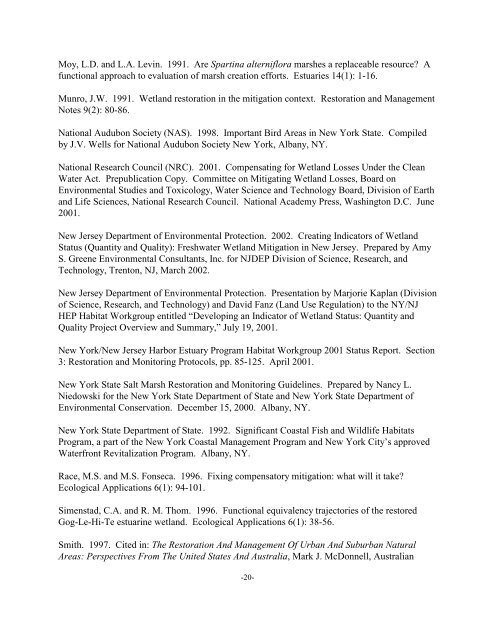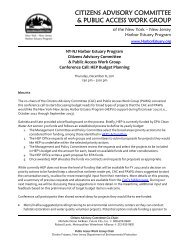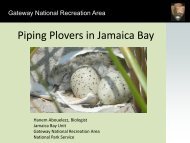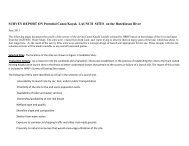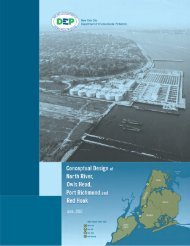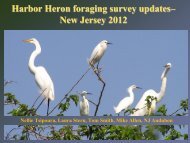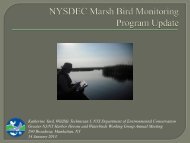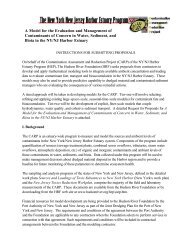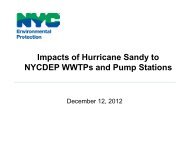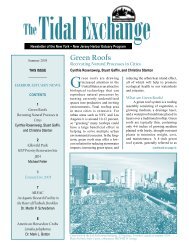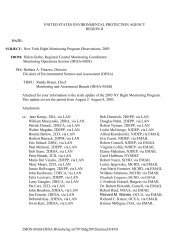DraftMitigation .pdf - New York-New Jersey Harbor Estuary Program
DraftMitigation .pdf - New York-New Jersey Harbor Estuary Program
DraftMitigation .pdf - New York-New Jersey Harbor Estuary Program
Create successful ePaper yourself
Turn your PDF publications into a flip-book with our unique Google optimized e-Paper software.
Moy, L.D. and L.A. Levin. 1991. Are Spartina alterniflora marshes a replaceable resource? A<br />
functional approach to evaluation of marsh creation efforts. Estuaries 14(1): 1-16.<br />
Munro, J.W. 1991. Wetland restoration in the mitigation context. Restoration and Management<br />
Notes 9(2): 80-86.<br />
National Audubon Society (NAS). 1998. Important Bird Areas in <strong>New</strong> <strong>York</strong> State. Compiled<br />
by J.V. Wells for National Audubon Society <strong>New</strong> <strong>York</strong>, Albany, NY.<br />
National Research Council (NRC). 2001. Compensating for Wetland Losses Under the Clean<br />
Water Act. Prepublication Copy. Committee on Mitigating Wetland Losses, Board on<br />
Environmental Studies and Toxicology, Water Science and Technology Board, Division of Earth<br />
and Life Sciences, National Research Council. National Academy Press, Washington D.C. June<br />
2001.<br />
<strong>New</strong> <strong>Jersey</strong> Department of Environmental Protection. 2002. Creating Indicators of Wetland<br />
Status (Quantity and Quality): Freshwater Wetland Mitigation in <strong>New</strong> <strong>Jersey</strong>. Prepared by Amy<br />
S. Greene Environmental Consultants, Inc. for NJDEP Division of Science, Research, and<br />
Technology, Trenton, NJ, March 2002.<br />
<strong>New</strong> <strong>Jersey</strong> Department of Environmental Protection. Presentation by Marjorie Kaplan (Division<br />
of Science, Research, and Technology) and David Fanz (Land Use Regulation) to the NY/NJ<br />
HEP Habitat Workgroup entitled “Developing an Indicator of Wetland Status: Quantity and<br />
Quality Project Overview and Summary,” July 19, 2001.<br />
<strong>New</strong> <strong>York</strong>/<strong>New</strong> <strong>Jersey</strong> <strong>Harbor</strong> <strong>Estuary</strong> <strong>Program</strong> Habitat Workgroup 2001 Status Report. Section<br />
3: Restoration and Monitoring Protocols, pp. 85-125. April 2001.<br />
<strong>New</strong> <strong>York</strong> State Salt Marsh Restoration and Monitoring Guidelines. Prepared by Nancy L.<br />
Niedowski for the <strong>New</strong> <strong>York</strong> State Department of State and <strong>New</strong> <strong>York</strong> State Department of<br />
Environmental Conservation. December 15, 2000. Albany, NY.<br />
<strong>New</strong> <strong>York</strong> State Department of State. 1992. Significant Coastal Fish and Wildlife Habitats<br />
<strong>Program</strong>, a part of the <strong>New</strong> <strong>York</strong> Coastal Management <strong>Program</strong> and <strong>New</strong> <strong>York</strong> City’s approved<br />
Waterfront Revitalization <strong>Program</strong>. Albany, NY.<br />
Race, M.S. and M.S. Fonseca. 1996. Fixing compensatory mitigation: what will it take?<br />
Ecological Applications 6(1): 94-101.<br />
Simenstad, C.A. and R. M. Thom. 1996. Functional equivalency trajectories of the restored<br />
Gog-Le-Hi-Te estuarine wetland. Ecological Applications 6(1): 38-56.<br />
Smith. 1997. Cited in: The Restoration And Management Of Urban And Suburban Natural<br />
Areas: Perspectives From The United States And Australia, Mark J. McDonnell, Australian<br />
-20-


